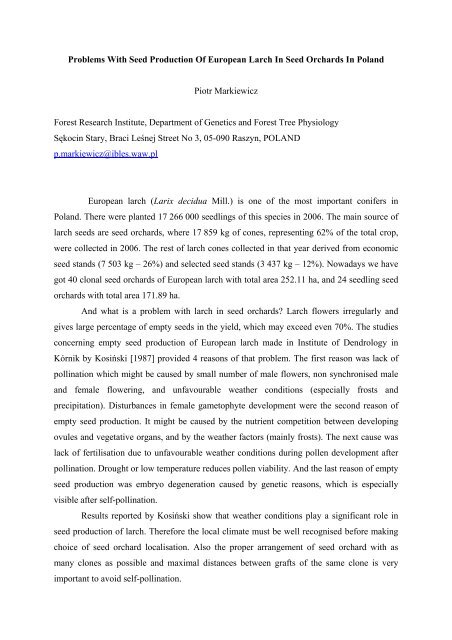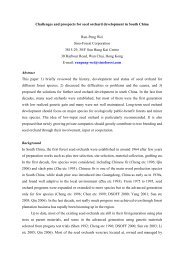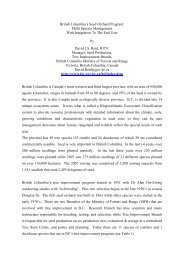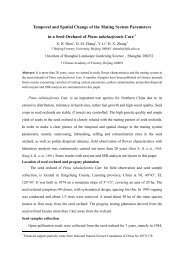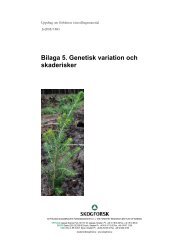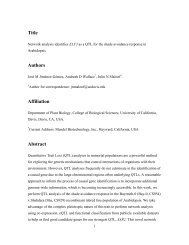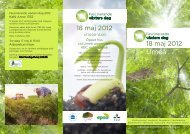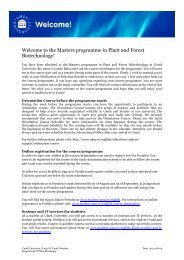Markiewicz - Forest Tree Breeding and Forest Genetics
Markiewicz - Forest Tree Breeding and Forest Genetics
Markiewicz - Forest Tree Breeding and Forest Genetics
- No tags were found...
You also want an ePaper? Increase the reach of your titles
YUMPU automatically turns print PDFs into web optimized ePapers that Google loves.
Problems With Seed Production Of European Larch In Seed Orchards In Pol<strong>and</strong><br />
Piotr <strong>Markiewicz</strong><br />
<strong>Forest</strong> Research Institute, Department of <strong>Genetics</strong> <strong>and</strong> <strong>Forest</strong> <strong>Tree</strong> Physiology<br />
Sękocin Stary, Braci Leśnej Street No 3, 05-090 Raszyn, POLAND<br />
p.markiewicz@ibles.waw.pl<br />
European larch (Larix decidua Mill.) is one of the most important conifers in<br />
Pol<strong>and</strong>. There were planted 17 266 000 seedlings of this species in 2006. The main source of<br />
larch seeds are seed orchards, where 17 859 kg of cones, representing 62% of the total crop,<br />
were collected in 2006. The rest of larch cones collected in that year derived from economic<br />
seed st<strong>and</strong>s (7 503 kg – 26%) <strong>and</strong> selected seed st<strong>and</strong>s (3 437 kg – 12%). Nowadays we have<br />
got 40 clonal seed orchards of European larch with total area 252.11 ha, <strong>and</strong> 24 seedling seed<br />
orchards with total area 171.89 ha.<br />
And what is a problem with larch in seed orchards? Larch flowers irregularly <strong>and</strong><br />
gives large percentage of empty seeds in the yield, which may exceed even 70%. The studies<br />
concerning empty seed production of European larch made in Institute of Dendrology in<br />
Kórnik by Kosiński [1987] provided 4 reasons of that problem. The first reason was lack of<br />
pollination which might be caused by small number of male flowers, non synchronised male<br />
<strong>and</strong> female flowering, <strong>and</strong> unfavourable weather conditions (especially frosts <strong>and</strong><br />
precipitation). Disturbances in female gametophyte development were the second reason of<br />
empty seed production. It might be caused by the nutrient competition between developing<br />
ovules <strong>and</strong> vegetative organs, <strong>and</strong> by the weather factors (mainly frosts). The next cause was<br />
lack of fertilisation due to unfavourable weather conditions during pollen development after<br />
pollination. Drought or low temperature reduces pollen viability. And the last reason of empty<br />
seed production was embryo degeneration caused by genetic reasons, which is especially<br />
visible after self-pollination.<br />
Results reported by Kosiński show that weather conditions play a significant role in<br />
seed production of larch. Therefore the local climate must be well recognised before making<br />
choice of seed orchard localisation. Also the proper arrangement of seed orchard with as<br />
many clones as possible <strong>and</strong> maximal distances between grafts of the same clone is very<br />
important to avoid self-pollination.
The next matter is that not all clones in seed orchard flower the same good as others.<br />
The question is how to equalise participation of all clones in flowering to increase genetic<br />
diversity of obtained seeds? Some activity like pollen collection <strong>and</strong> storage, supplemental<br />
mass pollination <strong>and</strong> controlled crossings may be the solution of this problem. Several<br />
artificial treatments can also stimulate flowering, mainly those which cause some kind of<br />
stress, such as drought, girdling, root pruning <strong>and</strong> root restrictions, tying stems in a knot,<br />
training whole trees or branches horizontally, <strong>and</strong> excessive nitrogen fertilization, or<br />
occasionally nutrient deficiency [Pharis at al. 1987]. Increased flowering of conifers through<br />
the use of plant hormones, especially the gibberellins (GAs), is possible as well. For species<br />
of Pinaceae, only GAs less polar then GA 3 , especially GA 4 , GA 7 , GA 5 , GA 9 <strong>and</strong> their<br />
combination, have generally been effective [Bonnet-Masimbert 1982].<br />
Some research works started in 2004 in European larch seed orchard in Syców (southwestern<br />
Pol<strong>and</strong>) confirmed positive influence of girdling on cone bud production<br />
[<strong>Markiewicz</strong> unpublished]. Girdled trees had 2-3-times higher mean grade of female<br />
flowering than control trees. The aim of girdling is to stop flow of assimilates from needles<br />
<strong>and</strong> shoots to the roots. The higher concentration of nutrients is required for buds to<br />
differentiate reproductively vs. vegetatively [Pharis at al. 1987]. But very important thing is to<br />
apply girdling at proper time of shoot development. Detectable differentiation of reproductive<br />
buds occurs in short shoots of western larch (Larix occidentalis Nutt.) at about the end of long<br />
shoot elongation [Eysteinsson <strong>and</strong> Greenwood 1995]. So treatment has to be applied during<br />
long shoot extension, before the end of this process. Girdling in seed orchard in Syców has<br />
been done when the long shoots have flushed <strong>and</strong> already had about 3-4 cm length.<br />
Girdling appears to be cheap <strong>and</strong> easy method to stimulate flowering but one has to be<br />
careful with this treatment, because it may lead to the root weakness <strong>and</strong> makes trees more<br />
susceptible to blowing down by the wind. Sometimes trees break in the girdle zone as well.<br />
However, girdling may be applied on trees which are designated for cutting from seed orchard<br />
in the near future.<br />
The influence of girdling on larch flowering in the next year after treatment was<br />
investigated in seed orchard in Syców in years 2005 <strong>and</strong> 2006. The increase of flowering<br />
caused by girdling observed in 2006 was lesser than in 2005. The reason might be that the<br />
year 2006 was good-flowering year in opposite to poor-flowering year 2005, <strong>and</strong> the positive<br />
influence of girdling might not be so evident when conditions were favourable for trees to<br />
flowering, <strong>and</strong> many trees naturally flowered well. So, this indicates that the flowering<br />
stimulation is economic only in the poor-flowering year, when almost all trees flower weakly.
However, the stimulation may enhance flowering, but not before the next year. So, there is a<br />
question, how to foresee in the year of stimulation if trees will naturally flower well or not in<br />
the next year, <strong>and</strong> make decision: stimulate or not stimulate? The answer to this question may<br />
be given by examination of correlation between the yield of seeds obtained in particular year<br />
<strong>and</strong> weather conditions occurred in the same year (influence on flowering <strong>and</strong> seed forming)<br />
<strong>and</strong> in the year before (influence on cone bud initiation). These investigations may give the<br />
knowledge which weather factors have the great impact on seed production, <strong>and</strong> how to<br />
foresee the flowering through the weather monitoring before flowering.<br />
And the last problem: seed collection. Larches in the young seed orchards, where seed<br />
collection is easy, flower rather weakly. Larches in the oldest seed orchards flower better, but<br />
the problem is that collecting seeds from high trees is technically difficult <strong>and</strong> more<br />
expensive. So, some research projects concerning top-pruning <strong>and</strong> crown forming of larches<br />
in seed orchards are needed. These projects aim to find efficient way of trees management,<br />
which may lead to:<br />
• limit the increase of trees height <strong>and</strong> keep crowns on the lower level,<br />
• reduce damages caused by the wind,<br />
• make easier seed collecting,<br />
• reduce costs of seed production <strong>and</strong> make seed orchards more effective.<br />
The observations made on pruned trees in a few following years may show what will be the<br />
influence of these treatments on flowering, survival <strong>and</strong> subsequent development of trees.<br />
Taking into consideration all these problems with seed production of larch, some<br />
studies providing knowledge about enhancing flowering, the weather influence on seed<br />
forming process, <strong>and</strong> managing trees in seed orchard, are still necessary.<br />
References<br />
Bonnet-Masimbert M. 1982. Effect of growth regulators, girdling, <strong>and</strong> mulching on<br />
flowering of young European <strong>and</strong> Japanese larches under field conditions. Can. J. For. Res.,<br />
12: 270-279.<br />
Eysteinsson T. <strong>and</strong> Greenwood M. S. 1995. Flowering on long <strong>and</strong> short shoots of Larix<br />
laricina in response to differential timing of GA 4/7 applications. <strong>Tree</strong> Physiology, 15: 467-<br />
469.
Kosiński G. 1987. Empty seed production in European larch (Larix decidua). For. Ecol.<br />
Manage., 19: 241-246.<br />
Pharis R. P., Webber J. E. <strong>and</strong> Ross S. D. 1987. The promotion of flowering in forest trees<br />
by Gibberellin A 4/7 <strong>and</strong> cultural treatments: a review of the possible mechanisms. For. Ecol.<br />
Manage., 19: 65-84.


